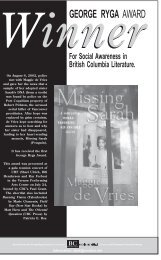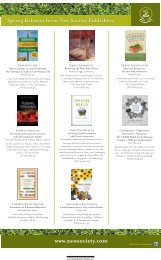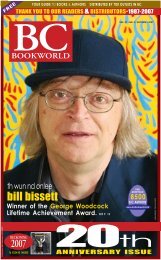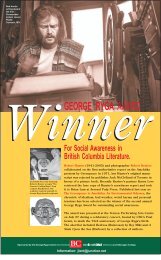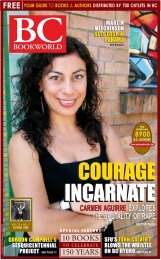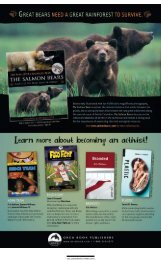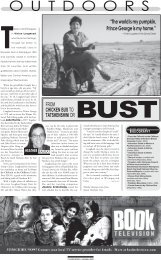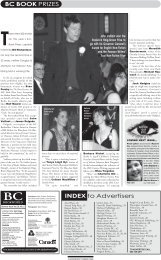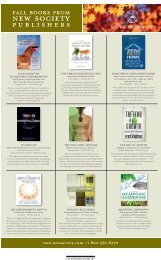BC letters - BC BookWorld
BC letters - BC BookWorld
BC letters - BC BookWorld
Create successful ePaper yourself
Turn your PDF publications into a flip-book with our unique Google optimized e-Paper software.
31 <strong>BC</strong> BOOKWORLD SUMMER 2009<br />
featureview<br />
NON-FICTION<br />
Robin Inglis stands alongside the modernist anchor<br />
erected at Spanish Banks, Vancouver, in 1986, to mark<br />
the approach of Spanish explorer Don José Maria Narváez<br />
in 1791 (prior to George Vancouver in 1792).<br />
Spaniard Juan Perez reached B.C. waters in 1774<br />
(prior to James Cook in 1778).<br />
Historical Dictionary of the Discovery<br />
and Exploration of the Northwest Coast<br />
of America by Robin Inglis<br />
(The Scarecrow Press $110 U.S.)<br />
When you go to a hockey<br />
or baseball game,<br />
there’s generally a program<br />
that provides the names<br />
and numbers of the players to<br />
enhance the meaning of the<br />
contest, to make the encounter<br />
into a better story. Similarly, if<br />
you go to the theatre, or open a<br />
Russian novel, there’s a list of<br />
characters provided at the outset<br />
to prevent you from losing<br />
your way.<br />
Robin Inglis’ mouthful-titled<br />
Historical Dictionary of the Discovery<br />
and Exploration of the Northwest<br />
Coast of America now provides a<br />
similar orientation service to<br />
untangle the fascinating blend<br />
of male and female characters<br />
and events that were formative<br />
influences on the early history<br />
of the last temperate coastline<br />
to be placed on the world map.<br />
For a succinct endorsement<br />
of this volume, one cannot do<br />
much better than cheer, “It’s<br />
about time!”<br />
✫<br />
After four years of concision,<br />
Inglis’ Northwest Coast, at 428<br />
pages, could have been twice as<br />
long, but it would have been half<br />
as valuable. Condensed-but-allinclusive,<br />
this authoritative<br />
guide casts a gigantic biographical<br />
net over a dizzying range of<br />
little-known Russian, British,<br />
French, Spanish and American<br />
mariners and traders.<br />
The first European known to<br />
ROBIN’S WHO’S WHO<br />
THE LAST WORD ON THE LAST COAST<br />
Robin Inglis untangles the fascinating blend of characters<br />
and events that were major influences on the early history of<br />
the last temperate coastline to be placed on the world map.<br />
have visited British Columbia<br />
waters was Juan Pérez, sailing<br />
from the San Blas naval base,<br />
south of San Diego, in 1774, to<br />
Langara Island (Haida Gwaii)<br />
and then south to the mouth of<br />
Nootka Sound (eastern Vancouver<br />
Island). He was followed by<br />
Captain Bodega y Quadra in<br />
1775, and more famously by Captain<br />
James Cook in 1778 (including<br />
young officers George<br />
Vancouver and William Bligh of<br />
Mutiny on the Bounty fame).<br />
Beyond that, most British<br />
Columbians know next-to-nothing,<br />
or simply nothing, about the<br />
first invaders of coastal First Nation’s<br />
lands, so Inglis has provided<br />
more than 400<br />
cross-referenced entries, along<br />
with a cogent introduction,<br />
maps and illustrations, an extensive<br />
bibliography (with advice on<br />
essential reference works) and<br />
an engaging chronology of<br />
events dating from the Treaty of<br />
Tordesillas in 1494 (when the<br />
Pope divided the undiscovered<br />
world between Spain and Portugal)<br />
and the purchase of Russian<br />
America by the United<br />
States in 1867.<br />
Whew. Inglis’ streamlined<br />
omnibus is the fourth volume in<br />
a series of historical dictionaries<br />
of discovery and exploration<br />
edited by Jon Woronoff who has<br />
noted there has been a tendency<br />
towards scholarly patriotism—or<br />
just laziness—in works<br />
about the North Pacific Coast.<br />
“Thus the greatest merit of<br />
the author,” according to<br />
Woronoff, “is to have placed<br />
equal and fair emphasis on all<br />
of the actors, including the<br />
Spanish, French and Russian,<br />
who all too often and unfairly<br />
come in a very distant second to<br />
the British and Americans.”<br />
This is true. The dozens of<br />
Russian names we encounter<br />
are made pleasing to learn when<br />
we know their numbers, the<br />
positions they play, their stats.<br />
Inglis has expanded North Pacific<br />
history into a new league.<br />
Who knew that Kirill Khlebnikov<br />
(1785-1838) was the official historian<br />
of the Russian-American<br />
In 2003, John R. Jewitt, a<br />
sixth-generation descendant of<br />
John Jewitt, traveled to Yuquot<br />
on the east side of Vancouver<br />
Island to meet with Mike<br />
Maquinna, a descendant of the<br />
Chief Maquinna who met<br />
Captain Cook in 1778. The two<br />
descendants first met as young<br />
men in October, 1987, at the<br />
Vancouver Maritime Museum,<br />
at which time the museum made<br />
available the dagger made by<br />
Jewitt for Chief Maquinna<br />
during his captivity.<br />
Company And that in 1953 his<br />
private papers revealed the<br />
long-lost journal of Vasilii<br />
Khromchenko, navigator for the<br />
Otto von Kotzebue expedition,<br />
1815-1818<br />
Better yet, this compendium<br />
is as trustworthy as it is culturally<br />
unbiased. As the guiding<br />
force behind Vancouver-based<br />
Instituto de Historia del Pacifico<br />
Español (Spanish Pacific History<br />
Society), Inglis, former director<br />
of the Vancouver Maritime Museum<br />
and North Vancouver<br />
Museum and Archives, has been<br />
able to benefit from the intelligence<br />
and knowledge of an impressive<br />
list of contacts such as<br />
Donald Cutter, Barry Gough,<br />
Glyndwr Williams, Derek<br />
Hayes, John Kendrick and Freeman<br />
Tovell—to mention only a<br />
few.<br />
Perhaps as a consequence of<br />
his intimidating peer group,<br />
Inglis assiduously avoids going<br />
out on limbs of scholarly conjecture.<br />
As to whether or not the<br />
mysterious Greek-born<br />
Apostolos Valerianos, better<br />
known as Juan de Fuca, might<br />
have reached a broad inlet between<br />
latitudes of 47 and 48<br />
degrees in 1592, Inglis will only<br />
condescend to agree this intriguing<br />
scenario “is not entirely<br />
outside the realm of possibility.”<br />
Inglis’ restraint in not including<br />
titillating tidbits is admirable.<br />
For instance, he limits his<br />
entry on the fantastical life of<br />
John Ledyard, ‘The American<br />
Marco Polo,’ to four paragraphs,<br />
continued on page 32



